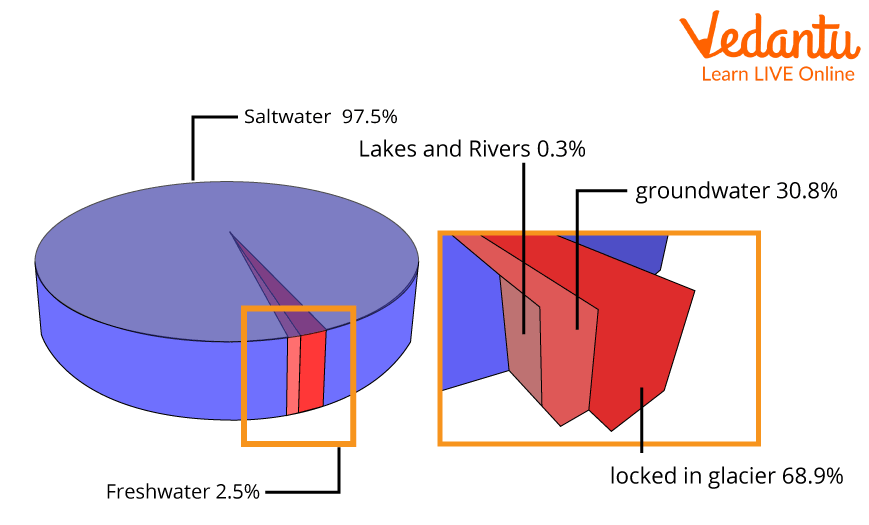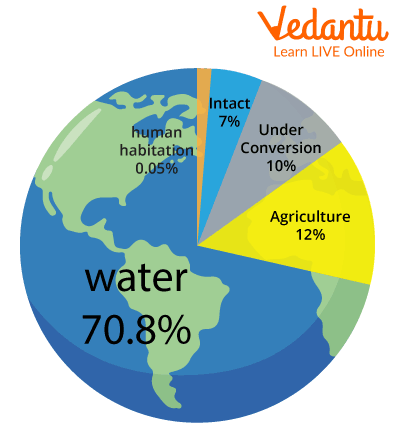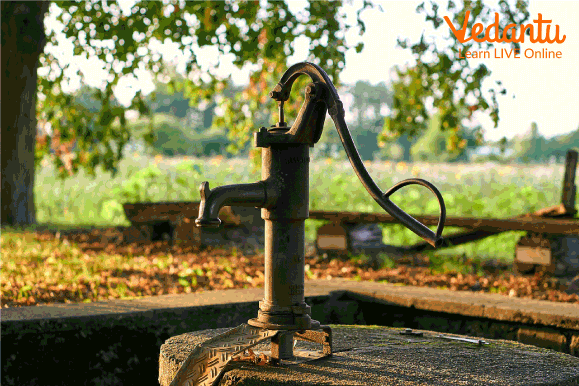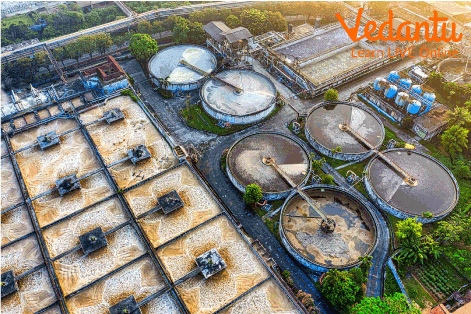




Introduction
Earth is also known as the blue planet because more than half of the Earth’s surface is covered with water. Water is present in oceans, rivers, ponds, and glaciers, but only a small amount of water is fit for humans to drink. The distribution of water on Earth tells us about the amount of water in various resources.

Pie Chart of Water Distribution on Earth
Distribution of Water and Land on Earth
Our planet Earth comprises land and water of which water is present in the majority. The distribution of land and water on Earth in percentage is - water covers approximately 70.8 % of the area while land covers 29.2 %. Water distribution on Earth's surface is highly unequal. Only 3 % of the water on the surface is clean; the other 97 % is in the ocean.
Freshwater is found in glaciers 69 % of the time, underground 30 % of the time, and in lakes, rivers, and swamps less than 1 % of the time. In other words, just 1 % of the water on Earth's surface is consumable for people, while 99 % of the useful quantity is underground.

Pie Chart of Land and Water Distribution On Earth
Types of Water on Earth
There are three different types of water resources in the world.
Surface Water - Surface water is water found in streams and lakes. This water is mostly utilised for drinking water, recreation, irrigation, industry, cattle, transportation, and hydroelectric electricity. The maintenance and purity of surface water are essential.
Saltwater - The planet's surface is rich with salt water. However, saltwater is ineffective when it comes to drinkable water supplies. Many people's diets across the world include saltwater fish. Coastal waters have also been used to create hydroelectric power.
Groundwater - Groundwater is the most abundant freshwater resource. Some of the water that filters down into the ground through layers of soil, clay, and rock, sticks to the highest layers providing water to plants. Gravity keeps the water moving downward through the earth. The water eventually reaches the saturated zone, when all the pores are filled with water. Groundwater feeds surface water through springs, while surface water may also restore groundwater supplies. Humans often obtain groundwater using wells.

Hand Pump Used for Groundwater Extraction
Wastewater Treatment
As the availability of water on Earth for drinking is less in amount, it is necessary to save water and reuse it. The water that we use and goes into the sinks needs to be cleaned to be used again. It goes through three major filtering stages.
First, unclean water is sent through a machine that, like a filter, filters out particles and other waste. That debris is cut into smaller pieces and disposed of in a landfill.
The residual water is then sent to an underground tank. Tiny creatures (bacteria) feed on the waste in the water here.
Finally, the water is sent to oceans, lakes, and rivers, or a final cleaning stage before being used to irrigate farmland or golf courses. After adding chlorine, this cleaned water can also be used as drinking water.

Wastewater Treatment Plant
Sample Questions
1. How much water is present as clean drinking water?
a. 10\[\% \]
b. 3\[\% \]
c. 15\[\% \]
d. 5\[\% \]
Ans. 3\[\% \]
Explanation: Out of 70\[\% \] of water present on the Earth only 3\[\% \] of water is available for drinking purposes. The remaining amount of water is present in oceans, rivers, and glaciers and cannot be used for drinking.
2. What is the source of clean drinking water?
a. Seas
b. Salt water lake
c. Wells
d. Oceans
Ans. Wells
Explanation: Rivers, ponds and oceans have salt present in large amounts, which cannot be consumed directly by human beings making it not fit for drinking.
3. ________ is not the source of salt water.
a. Ponds
b. Oceans
c. Rivers
d. Sea
Ans. Ponds and River
Explanation: Oceans and seas have a huge amount of salt dissolved in them naturally. Rivers are natural water sources containing fresh water, whereas ponds are man-made and do not have salt in them.
Conclusion
In this chapter we have studied about the distribution of land and water on earth and other facts like water is dispersed quite unevenly throughout the surface of the earth. The fresh water contains around three percent of earth. And very few percent of fresh water is found in lakes , rivers etc. We have also covered the types of water and how we can stop wasting water by adapting the wastewater treatment.
FAQs on Water Distribution on Earth
1. What is the overall distribution of water on Earth?
Approximately 71% of the Earth's surface is covered by water. However, this water is not evenly distributed or equally usable. About 97% of all water is saltwater found in oceans, while only about 3% is freshwater, which is essential for most life on land, including humans.
2. How is the Earth's limited freshwater distributed across different sources?
The small percentage of freshwater on Earth is distributed across various sources, with most of it being inaccessible. The breakdown is as follows:
- Glaciers and Ice Caps: Approximately 68.7% of all freshwater is frozen in ice caps and glaciers.
- Groundwater: About 30.1% is stored underground in soil and rock formations called aquifers.
- Surface Water: Only about 1.2% of freshwater is on the surface in lakes, rivers, swamps, and soil moisture, making it the most accessible source for human use.
3. If most of the Earth is covered in water, why do we face water scarcity?
We face water scarcity because the vast majority of Earth's water (97%) is saline (salty) and unsuitable for drinking, agriculture, or most industrial uses without expensive desalination. Of the remaining 3% that is freshwater, most is locked away in glaciers and deep groundwater. This leaves less than 1% of the planet's total water readily accessible for human needs, creating scarcity in many regions.
4. Why is ocean water salty and not suitable for most human uses?
Ocean water is salty because it contains a high concentration of dissolved minerals and salts, primarily sodium chloride. This high salinity makes it unsafe for humans to drink as our kidneys cannot process that much salt. It is also damaging to most agricultural crops and can be corrosive to industrial equipment, making it unsuitable for most day-to-day uses.
5. What is the main difference between surface water and groundwater?
The main difference lies in their location. Surface water is any body of water found on the Earth's crust, such as rivers, lakes, ponds, and reservoirs. It is easily visible and accessible. In contrast, groundwater is water that has seeped below the surface and is stored in underground layers of rock or soil known as aquifers. While groundwater is a much larger reservoir of freshwater, it must be accessed by digging wells or through natural springs.
6. Why is most of the Earth's freshwater frozen in glaciers and ice caps?
Most of Earth's freshwater is frozen due to the planet's climate patterns and history. In the polar regions and at high mountain altitudes, average temperatures are consistently below freezing. This causes precipitation to fall as snow and accumulate over thousands of years, compacting into vast sheets of ice. This frozen water represents the largest single store of freshwater on Earth, preserved from past ice ages.
7. What are some important examples of how we use freshwater?
Freshwater is critical for all aspects of human life and society. Its primary uses include:
- Domestic Use: For drinking, cooking, cleaning, and sanitation in our homes.
- Agriculture: For irrigating crops and watering livestock, which is the largest consumer of freshwater globally.
- Industrial Use: For manufacturing processes, cooling systems, and producing goods.
- Energy Production: For generating power in hydroelectric plants.
8. How does understanding water distribution help us with water conservation?
Understanding the distribution of water reveals that accessible freshwater is an extremely rare and finite resource. Realising that less than 1% of all water on Earth is available for our needs highlights its immense value. This knowledge encourages us to practice water conservation by avoiding wastage, preventing pollution of rivers and lakes, and using water more efficiently in our homes and industries to protect this precious supply for the future.





















